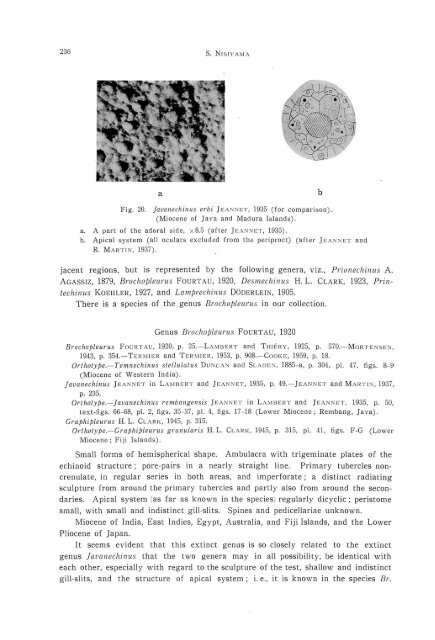the echinoid fauna from japan and adjacent regions part i
the echinoid fauna from japan and adjacent regions part i
the echinoid fauna from japan and adjacent regions part i
Create successful ePaper yourself
Turn your PDF publications into a flip-book with our unique Google optimized e-Paper software.
236 S. NISIYAMA<br />
a<br />
Fig. 20. Javanechinus erbi J EA N NET, 1935 ( for comparison).<br />
(Miocene of J ava <strong>and</strong> Madura Is l<strong>and</strong>s) .<br />
a. A <strong>part</strong> of <strong>the</strong> adoral s id e, x S.5 (after J EA NN ET, 1935).<br />
b. Apical system (al l oculars excluded <strong>from</strong> <strong>the</strong> periproct) (after J EANN ET <strong>and</strong><br />
R. M ART IN, 1937).<br />
jacent <strong>regions</strong>, but is represented by <strong>the</strong> following genera, viz., Prionechinus A.<br />
AGASSIZ, 1879, Brochopleurus FOURTAU, 1920, Desmechinus H. L. CLARK, 1923, Printechinus<br />
KOEHLER, 1927, <strong>and</strong> Lamprechinus DOOERLEIN, 1905.<br />
There is a species of <strong>the</strong> genus Brochopleurus in our collection.<br />
Genus Brochopleurus FOURTAU, 1920<br />
Brochopleurus FOURT AU, 1920, p. 25.- L AM BERT <strong>and</strong> THIERY, 1925, p. 570.- M oRTE NS EN,<br />
1943, p. 354.- T ERM IER <strong>and</strong> T ERM IER , 1953, p. 90S.- COOKE, 1959, p. IS.<br />
Orthotype.- T emnechinus stellulatus DU NCAN <strong>and</strong> SL ADE N, lS85- a , p. 304, pI. 47, figs. 8- 9<br />
(Miocene of Western India).<br />
Javanechinus J EANN ET in L AMBERT <strong>and</strong> J EANN ET, 1935, p. 49.- J EAN NET <strong>and</strong> M ARTI N, 1937,<br />
p. 235.<br />
Orthotype.-Javanechinus rembangensis J EA NN ET in L AMBE RT <strong>and</strong> J EAN NET, 1935, p. 50,<br />
text-figs. 66- 68, pI. 2, figs. 35- 37, pI. 4, figs. 17- 18 (Lower Miocene; Rembang, Java).<br />
Graphipleurus H. L. CL ARK, 1945, p. 315.<br />
Orthotype.- Graphipleurus g ranularis H. L. CL ARK, 1945, p. 315, pI. 41, figs. F-G (Lower<br />
Miocene; F iji Isl<strong>and</strong>s).<br />
Small forms of hemispherical shape. Ambulacra with trigeminate plates of <strong>the</strong><br />
<strong>echinoid</strong> structure; pore-pairs in a nearly straight line. Primary tubercles noncrenulate,<br />
in regular series in both areas, <strong>and</strong> imperforate; a distinct radiating<br />
sculpture <strong>from</strong> around <strong>the</strong> primary tubercles <strong>and</strong> <strong>part</strong>ly also <strong>from</strong> around <strong>the</strong> secondaries.<br />
A pical system (as far as known in <strong>the</strong> species) regularly dicyclic ; peristome<br />
small, with small <strong>and</strong> indistinct gill-slits. Spines <strong>and</strong> pedicellariae unknown.<br />
Miocene of India, East Indies, Egypt, A ustralia, <strong>and</strong> Fiji Isl<strong>and</strong>s, <strong>and</strong> <strong>the</strong> Lo\ver<br />
Pliocene of Japan.<br />
It seems evident that this extinct genus is so closely rela ted to <strong>the</strong> extinct<br />
genus Ja vanechinus that <strong>the</strong> two genera may in all possibility, be identical with<br />
each o<strong>the</strong>r, especially with regard to <strong>the</strong> sculpture of <strong>the</strong> test, shallow <strong>and</strong> indistinct<br />
gill-slits, <strong>and</strong> <strong>the</strong> structure of apical system; i. e., it is known in <strong>the</strong> species Br.<br />
b












